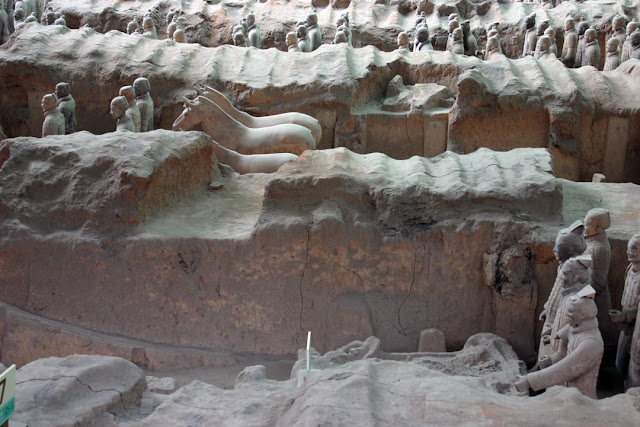One of the highlights from my trip was finally seeing the Terracotta Warriors. For those who may not be familiar with the warriors let me give a quick history. The army was built to surround the tomb of China's first emperor, Qin Shi Huangdi. During his rule the Qin Dynasty emerged out of the warring states period establishing a singular written script, national road system and other infrastructure that became the foundation for a unified China. The army is part of a larger burial complex spread over 22 square miles. (In comparison the Island of Manhattan in New York City is 22.7 square miles.) Since farmers first discovered a warrior shard in 1975 a slow excavation has taken place. While most of the network of 600 pits has not been excavated, approximately 7,000 figures have already been found. (For more detailed history check out this article from the Smithsonian Magazine.)
The museum that I visited is focused on three main pits. The stark contrast between the exterior building and the interior pits is breath taking. My first view of the warriors will be permanently burnt into my memory. After a short 10 ft hallway the building opens up to a room that spans the entire length of the pit. The pit is 750 ft by 200ft, or roughly the size of 2 football fields stacked longways. The buildings high partitioned roof allows light to bath the figures while keeping them safe from the elements. After visiting all three pits I felt humbled from the amount of labor involved in the creation of the army. I have a hard time wrapping my head around the output of skilled labor that was necessary to individually detail the armor, facial features, and weapons of the warriors. Even from its beginning China has been willing to expend man power on a scale that few others can match.
One of my favorite images of the trip is the eighth picture from the top. Fragments of the warriors are scattered around the pit like a puzzle waiting to be finished. Some of the fragmentation was caused by looters ransacking the warriors for their metal weapons and some was the natural effect of burial. Imagine the difficult reality of excavating this site. The picture above it shows pigment samples that where left in the dirt surrounding one of the warrior's hands. After more than 2000 years the warriors, like the sun bleached sculptures of Greek antiquity, have completely lost their original color. It is interesting how time reduces a material to its most durable color.
My visit to the warriors left me wondering what our culture will leave behind. Our burial practices don't include objects as durable as ceramic replicas, so how will future generations look back at our time? Will we be remembered by the non-biodegradable Mcdonalds cartons that fill our landfills, or for the art that hangs in our museums? Will we organize our wealth to document our living history, or will we focus on transient pleasures while fading into obscurity? Will the digital age step in allowing the individual and the culture to record its history in a permanent but invisible data cloud? These questions show that our distant history is often the best inspiration to live and document a more memorable life in the present.
This is the second installment of a travel series on the Northern Chinese City of Xi'an. The first installment can be viewed by clicking the following link A few days in Xi'an pt.1 The City Wall and the Muslim Quarter. Check back later in the week for the next post on sculpture from the Shaanxi History Museum.













Great to see the photos of Xi'an. My daughter lives there. My two eldest sons just spent a month in China with her but weren't interested in going to see the terra-cotta warriors. They were more interested in the food they got in the Muslim quarters.Did you see any contemporary potters?
ReplyDeleteHope to go there one day myself!
Hello Margaret,
ReplyDeleteThanks for the comment. That is great that you daughter lives in Xi'an. Is she teaching there? I can't believe your sons didn't want to see the warriors. By far one of the coolest historical sights that I have seen in China.
I didn't meet any contemporary potters there. If I go back I would like to learn more about the clay and firings that are typical for the area. I've heard the warriors were fired in updraft beehive kilns but I'm not sure if that's true.
Have a good day and happy potting.
Thanks for the comment. Yes my daughter teaches English as a foreign language to childern.
ReplyDelete